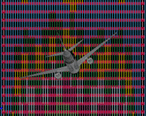
« PREVIOUS ENTRY
The oldest writing found in the West
NEXT ENTRY »
Two new games from Ian Bogost

By now, you’ve probably read about the many 9/11 conspiracy theories. A lot of them argue that the World Trade Center buildings were intentionally demolished by controlled explosions. That’s because, as the conspiracy theorists argue, a jetliner collision would not be sufficient on its own to destroy the buildings. Now, the whole reason this theory has gotten any legs at all is that it’s impossible to test it in the physical world; no-one’s going to fly a plane into a massive skyscraper just to prove or disprove whether it would destroy it.
But now a team of computer scientists at Purdue going to settle the matter — by running a virtual simulation of the planes hitting the WTC buildings. So far, they’ve spent 80 hours using a 16-processor computer to simulate the first half-second of impact. (That’s a still from it above.) The early results are intriguing, and — as you might expect — debunk the conspiracy theories. As a story on the Purdue site notes:
“Current findings from the simulation have identified the destruction of 11 columns on the 94th floor, 10 columns on the 95th floor and nine columns on the 96th floor,” he said. “This is a major insight. When you lose close to 25 percent of your columns at a given level, the building is significantly weakened and vulnerable to collapse.”
By the way, I should point out that the Purdue research wasn’t initiated specifically in response to the conspiracy theories; they’re doing it both just as pure research and to get a better understanding of engineering frailties. But it’s still a pretty interesting way to help put some of these rumors to rest.
Indeed, this is one of the principles behind many “serious games”: That simulations can be terrific ways to test out theories. Right after 9/11, I remember hearing that a lot of pilots cracked open their copies of Microsoft Flight Simulator, dialled up the 747, and tried to see if they could crash it into the buildings. It wasn’t disrespectful or gratuitous. They were as traumatized as anyone else — maybe even more so, given their profession — and this was a way of emotionally coping; they wanted to see if it were really that easy to hit the buildings.
I’m also reminded of JFK Reloaded, the game that put you in Lee Harvey Oswald’s shoes and tried to see if you could perfectly replicate the way JFK was killed. The concept behind the game was actually quite smart: If there’s a conspiracy theory arguing that a lone gunman couldn’t have pulled off the assasination, then why not create a sim and let people see if it were possible? In the game, you could also place yourself on the grassy knoll and see for yourself how it changed the head-wound ballistics.
The problem with JFK Reloaded was while the concept was interesting, the designer went rather overboard; there was arguably no need to so precisely emulate the flying pieces of bodily flesh, as the game did. (And there’s something inherently creepy about shooting not at fictional, anonymous, imaginary enemies, but at real-life folks, including one whom is still alive. I wrote a piece for Slate making this point, but it was unfortunately rather incoherent — I was on a tight deadline — and I don’t think I adequately argued that the concept of a historical sim is not necessarily a bad thing.)
Anyway, I’ll be intrigued to hear the full results of this Purdue simulation!
I'm Clive Thompson, the author of Smarter Than You Think: How Technology is Changing Our Minds for the Better (Penguin Press). You can order the book now at Amazon, Barnes and Noble, Powells, Indiebound, or through your local bookstore! I'm also a contributing writer for the New York Times Magazine and a columnist for Wired magazine. Email is here or ping me via the antiquated form of AOL IM (pomeranian99).

ECHO
Erik Weissengruber
Vespaboy
Terri Senft
Tom Igoe
El Rey Del Art
Morgan Noel
Maura Johnston
Cori Eckert
Heather Gold
Andrew Hearst
Chris Allbritton
Bret Dawson
Michele Tepper
Sharyn November
Gail Jaitin
Barnaby Marshall
Frankly, I'd Rather Not
The Shifted Librarian
Ryan Bigge
Nick Denton
Howard Sherman's Nuggets
Serial Deviant
Ellen McDermott
Jeff Liu
Marc Kelsey
Chris Shieh
Iron Monkey
Diversions
Rob Toole
Donut Rock City
Ross Judson
Idle Words
J-Walk Blog
The Antic Muse
Tribblescape
Little Things
Jeff Heer
Abstract Dynamics
Snark Market
Plastic Bag
Sensory Impact
Incoming Signals
MemeFirst
MemoryCard
Majikthise
Ludonauts
Boing Boing
Slashdot
Atrios
Smart Mobs
Plastic
Ludology.org
The Feature
Gizmodo
game girl
Mindjack
Techdirt Wireless News
Corante Gaming blog
Corante Social Software blog
ECHO
SciTech Daily
Arts and Letters Daily
Textually.org
BlogPulse
Robots.net
Alan Reiter's Wireless Data Weblog
Brad DeLong
Viral Marketing Blog
Gameblogs
Slashdot Games